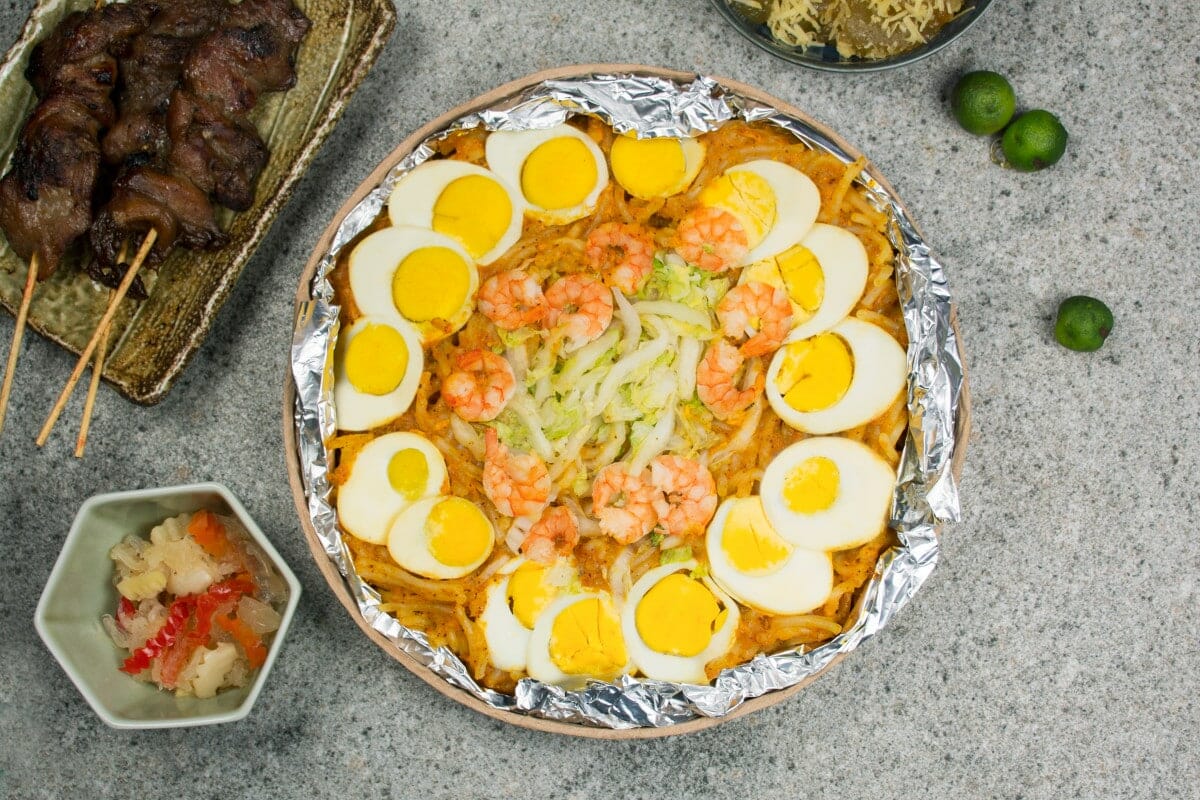
Filipino culture may not be as well-known as some of its East Asia and Southeast Asia neighbors. But the Philippines benefits from a rich, diverse hodgepodge of influences from all over the world. And one thing that benefited most from this long history of adaptation and assimilation is the food.
The traditional methods of cooking are regularly lauded as the “next best thing” by influencers and celebrity chefs, usually after their first visit to the Philippines. Anthony Bourdain even described dishes from the Philippines as “a labor of love” and remarked that “American taste buds were ready for the bold flavors, and the sour notes, that characterized some Filipino dishes”. Bourdain and other well-known celebrities helped open the doors to the world of Filipino cuisine.
Filipino food has a distinct flavor profile noticeable throughout the country’s many, many dishes. Filipino food is typically sweet, salty, sour, tangy, and umami. Recipes influenced by the country’s abundant natural resources create what we now know as “Filipino cuisine”. And then there are the more exotic and wonderfully weird dishes you only find in the Philippines.
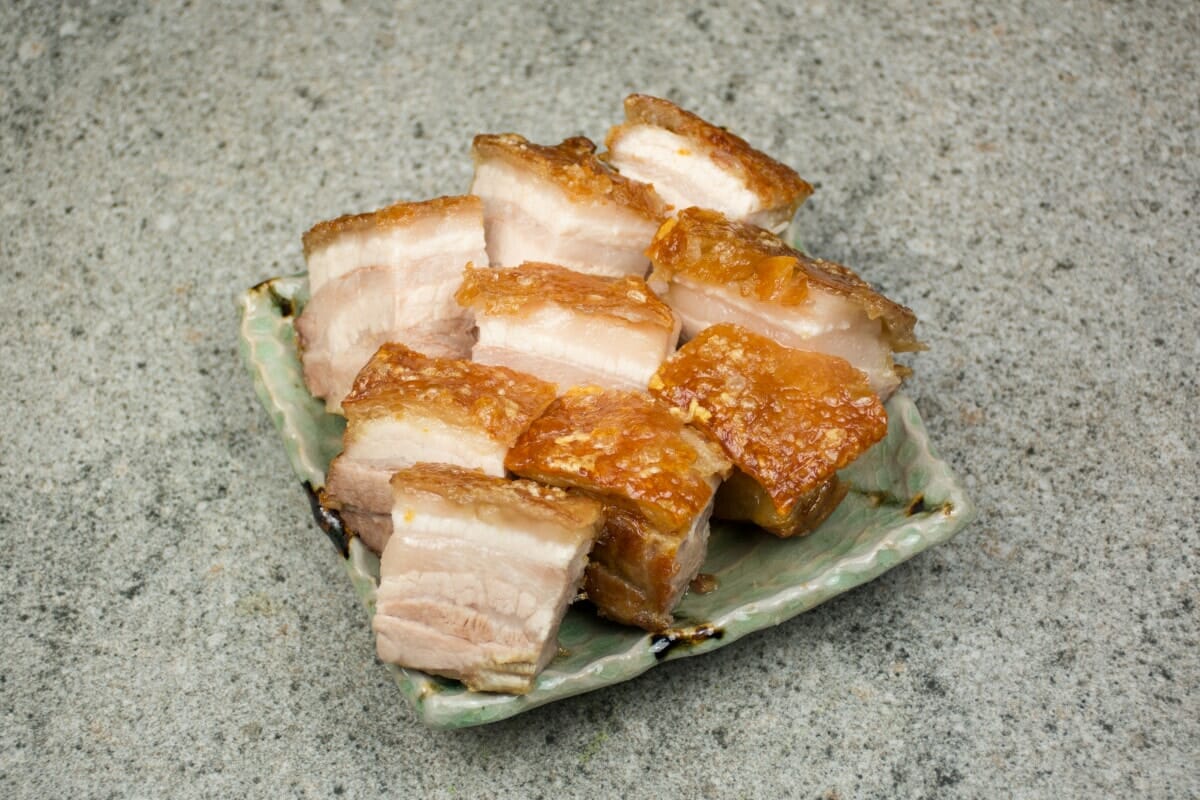
A Brief History of Filipino Food
Filipino food is a diverse melting pot of Eastern and Western cuisine. Historically, the Philippines was coveted by world powers as a strategic area, one with a bountiful supply of fruits, vegetables, meat and seafood. These advantages helped make the Philippines a focal point of trade in the region (and beyond). Malay-Polynesian peoples were one of the first settlers in around 3,000 BCE, and introduced rice to the archipelago. Later settlers, like the Spanish, American, and Japanese also introduced resources, cooking methods, and ingredients that have helped create delicious food that Filipinos now consider their own.
Enjoy our whirlwind guide to some of the top foods to eat if you travel to the Philippines. These are some of the most popular foods you can try in a Filipino restaurant, from a street food vendor, or make at home yourself with a good Filipino recipe.
Adobo
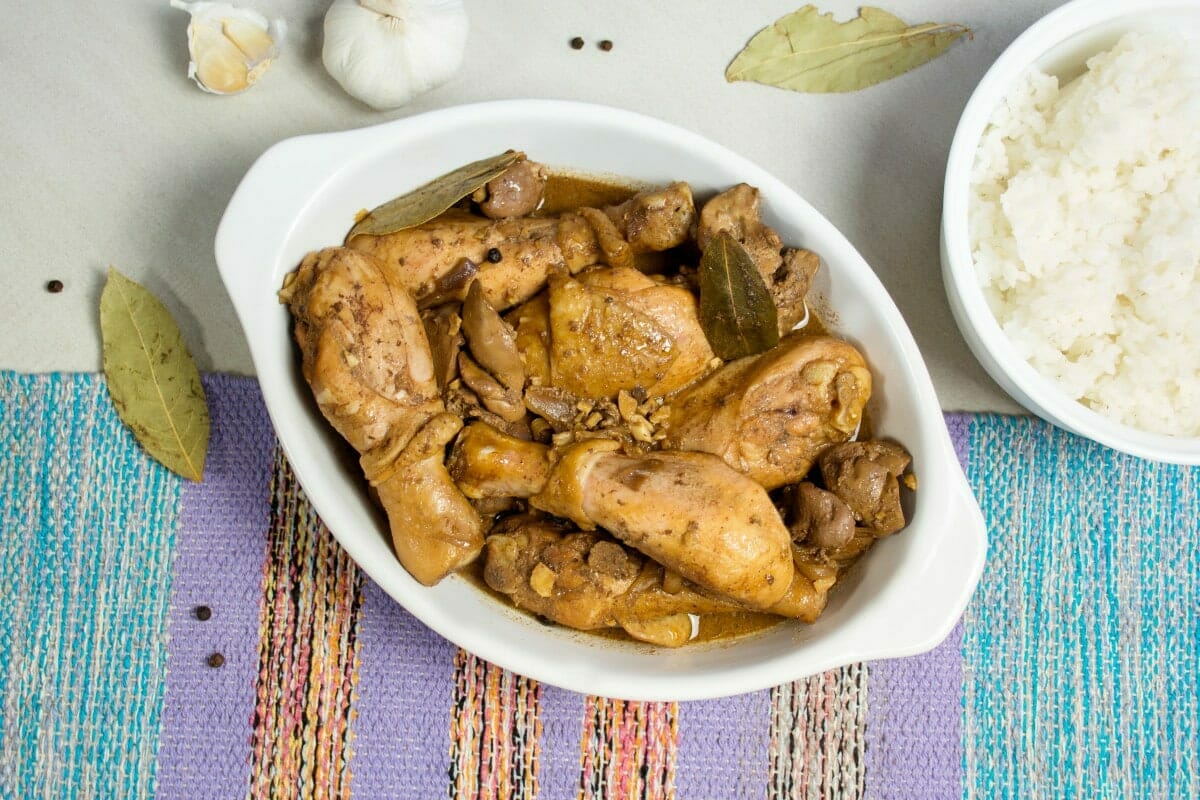
Adobo is possibly the most famous Filipino food. Some might even consider Adobo’s taste the embodiment of Filipino cuisine. This savory, tangy, rich, and flavor-packed dish is a splendid example of the distinct flavor Filipino dishes express. Chicken adobo is the most popular variation of this must-try dish. Even seafood is used but chicken or pork are the most commonly seen variations.
There's even a popular chicken feet adobo recipe.
Adobo is, without doubt, the national dish of the Philippines. Adobo is both a saucy main dish and a cooking process or method that uses garlic, onions, soy sauce, vinegar, bay leaves, and black peppercorns. There are unlimited recipe variations that include pork, eggplant, chicken, liver or seafood simmered in broth, all combined with potatoes and egg. Some experimental recipes use coconut milk to create a sweeter and creamier flavored adobo, while others add spices like turmeric or paprika, which give a more sweet, pungent or bitter aspect to the dish.
The combination of garlic, onions, turmeric, and coconut milk makes us wonder why this dish is not championed as a true superfood. After all, the vitamin and mineral value is high in this deceptively healthy dish.
Adobo dishes are very common in the Philippines. Pork adobo is another incredibly tasty and popular dish. and the basic dish is still regarded as a perfect example of local cuisine and embodies a taste profile that every Filipino can be proud of.
Sinigang
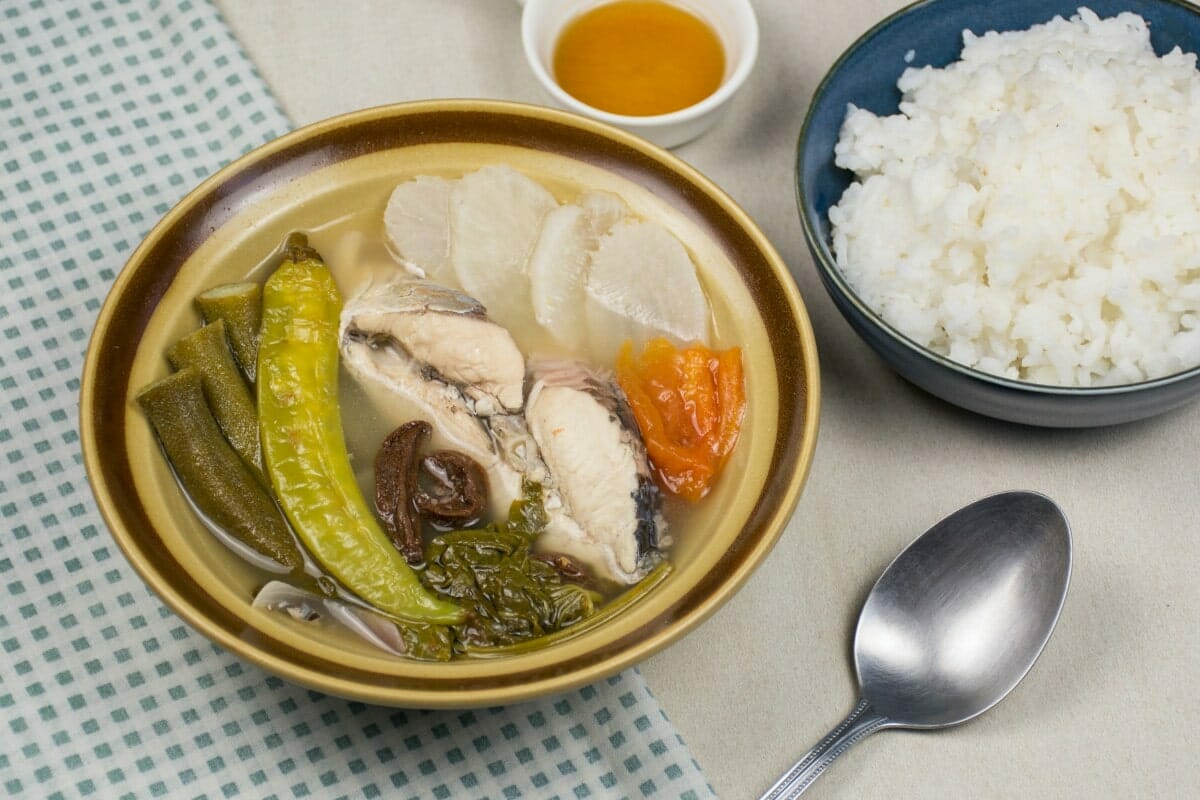
Sinigang is a savory, sour soup believed to be an original recipe that has survived untouched by the influence of Spanish colonizers. A versatile dish prepared in a pot filled with a variety of proteins such as fish, shrimp, or chicken, and vegetables such as onion, okra, radish, spinach, eggplant, and tomatoes.
To give sinigang a sour taste, Filipinos add tamarind or guava as souring agents (sour is a popular flavor in the Philippines). The proteins, veg, and souring agent are boiled in a pot. This is a food you can cook and enjoy anytime. It’s suitable for breakfast, lunch, and dinner. Enjoy the unique taste with a bowl of steamed rice.
Depending on the city or region, sinigang’s ingredients vary. Sinigang na Bangus or milkfish sinigang is from Pangasinan and uses “santol” or “cotton fruit” as a souring agent. This gives the soup its milky pinkish hue. Quezon city recipes tend to use calamansi juice as their souring agent. Another popular version Sinigang na Baboy includes bagoong alamang or shrimp paste as a side dip. Some Filipinos add chili peppers for a bit of spice and gabi (taro roo) as a thickener.
Bulalo
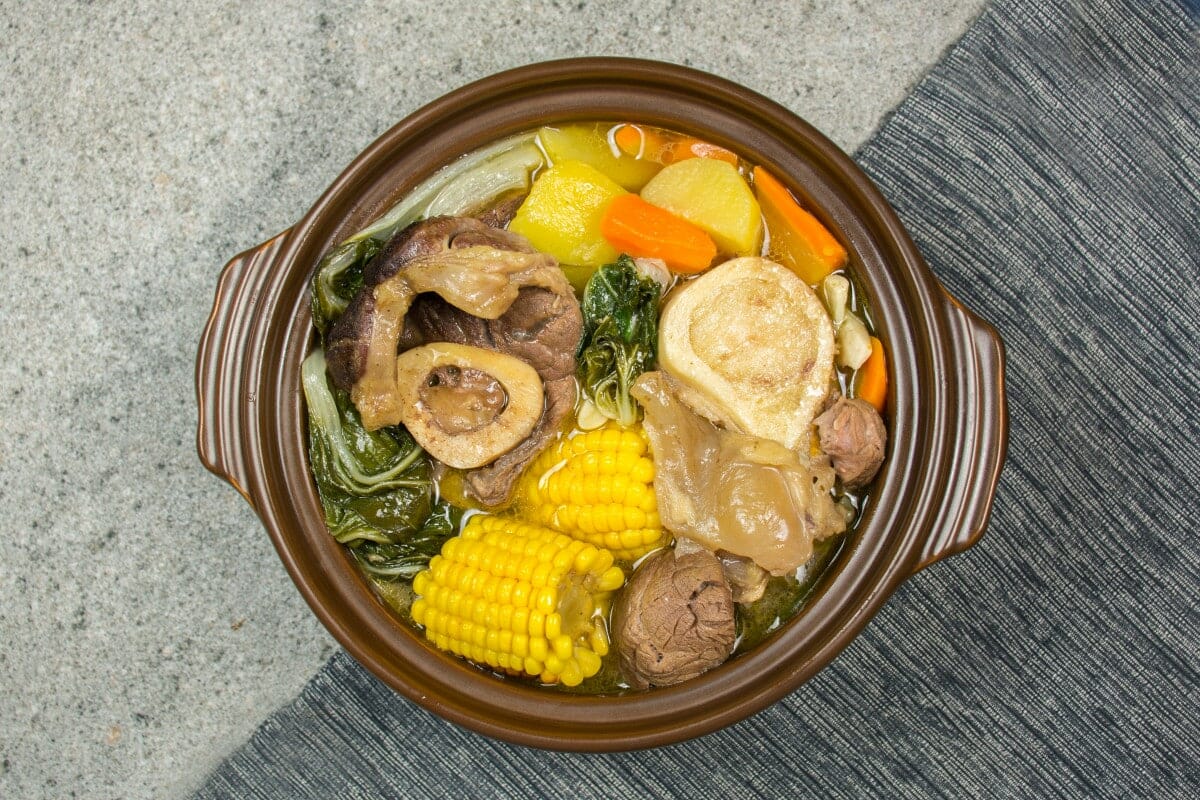
Bulalo is a simple savory stew made of beef shank, bone marrow, garlic, fish sauce, soy sauce, peppercorns, and potatoes. Light in color, and sweetened by the addition of carrots, leafy vegetables like cabbage or pechay (a Filipino term for Chinese cabbage), onions, ginger, corn, and other seasonings. Everything is boiled in a large pot for several hours until the beef shank has tenderized and the collagen from the marrow has melted away into the clear broth.
Bulalo originated from the southern region of Luzon in the 1560s. There are even bulalo specialty restaurants, called bulalohan, mostly found in the provinces of Tagaytay and Batangas (just south of Metro Manila). Filipinos eat bulalo for dinner, to combat chilly nights, or as a hangover cure.
The bone marrow in the bulalo is the star of the dish and extracting it with a small spoon or thin stick is part of the ritual. The best bulalo dishes have marrow that easily slides off the bone. Add a few drops of soy sauce, sili, and cups of steamed rice and you’ve got a great meal to end the day. This is one of the tastiest beef dishes in the Philippines.
Inasal Chicken
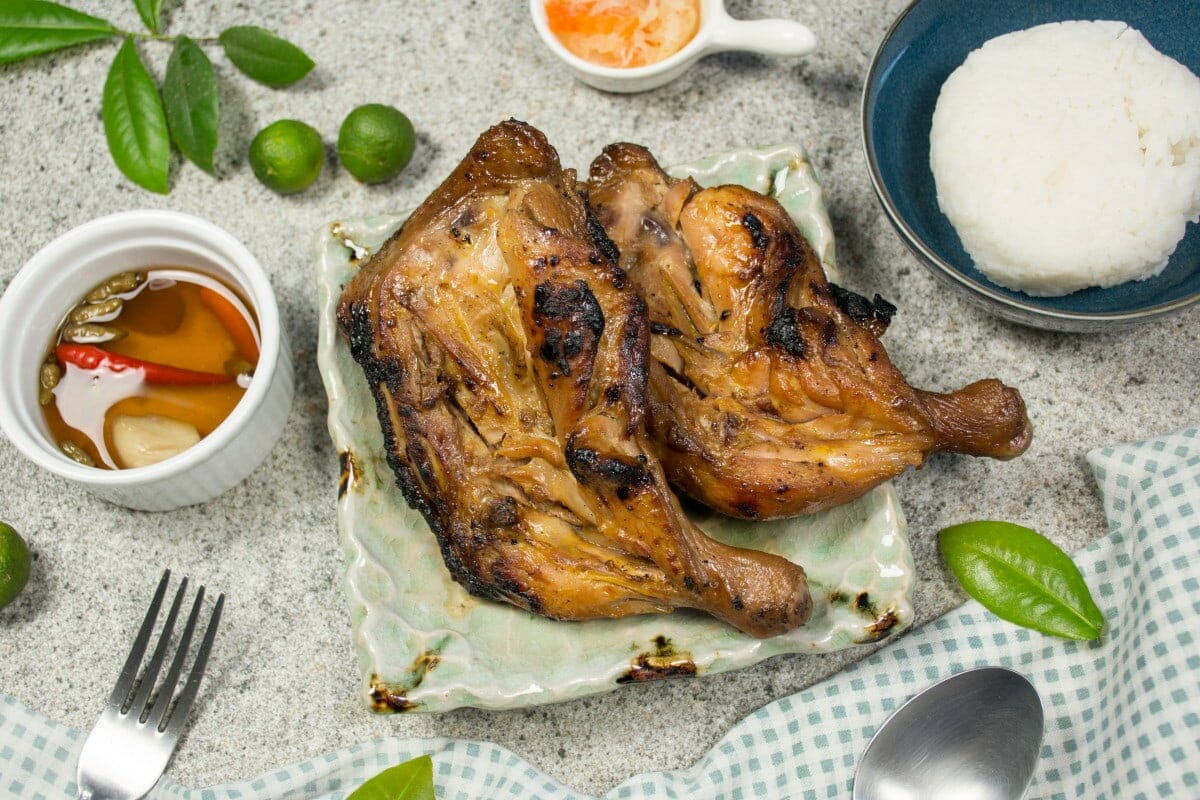
Chicken inasal or inasal na manok is a grilled chicken dish from the province of Bacolod in the Visayas region (central area where Cebu is located) of the Philippines. The city of Bacolod, known as the “City of smiles”, named this recipe “Inasal”, an Ilonggo term for roasted meat or chargrilled chicken. Chicken inasal is a dish made with a signature marinade composed of vinegar, lemongrass, garlic, ginger, calamansi, and sinamak, a spiced vinegar originating from the province of Iloilo. Sinamak is made of garlic, chili pepper, ginger, and coconut vinegar. Delicious.
The marinated chicken is usually cooked on a grill but can also be done in an oven or on a stove. The chicken gets a brushing of atsuete oil while it grills. Atsuete oil (also called annatto oil and achiote oil) gives the chicken its peppery taste and golden color. Chicken Inasal pairs well with atsuete-garlic fried rice and spiced vinegar as a side dipping sauce.
Crispy Pata
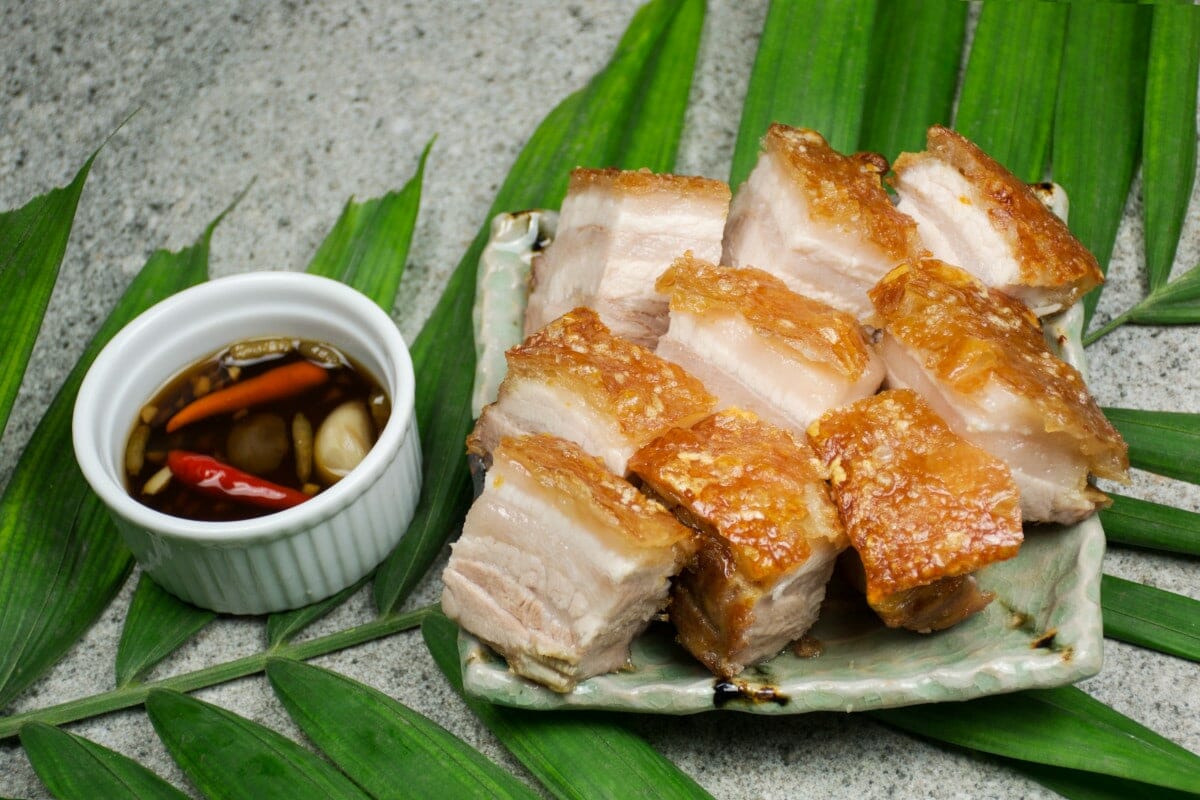
An indulgent crispy deep-fried pork dish is known for its delicious golden skin, and tender white meat. Crispy pata is a treat for the senses thanks to the savory taste, mouthwatering smell, and the crackle of skin as the meat is cut or enjoyed. A treat for meat lovers seeking deep-fried perfection. Don’t miss the opportunity to try real Filipino crispy pata, especially if you’re fond of lechon, another incredibly popular dish. A best seller in any restaurant, crispy pata is made from pig hock with pork knuckle or pork leg.
Crispy pata is a treat for meat lovers
The basic recipe is prepared like this: cooks remove the hairs on the skin by scraping or burning it with fire. Next, it’s boiled with spices such as brown sugar, vinegar, garlic, peppercorns, bay leaves, fish sauce, anise, onion and other spices. The meat is then deep fried till the skin has turned crispy and puffed up with bubbles. Inside, the meat is still soft and moist from the layers of fat.
Pair with beer and dip into a spicy vinegar-soy sauce mixture for the ultimate taste experience. Crispy pata is challenging to make at home, but it’s worth the effort.
We must mention liempo (grilled pork belly – one of the best-loved Filipino dishes) which can be served deep-fried (lechon kawali) or roasted suckling pig (simply known as lechón). Either way, it's delicious and another popular way to serve the juicy, fatty meat treated almost like comfort food.
Pork belly might not sound appealing to everyone but trust me when I say that deep fried pork belly or grilled pork belly Filipino-style are two of the world's tastiest foods.
Lechón is a masterpiece of flavor and texture. On special occasions, an entire roasted suckling pig stuffed with star anise, spring onions, pepper, and lemongrass, and served without further condiments, sauces, or toppings. The taste of this pork barbeque is incredible and needs no refinement.
Silog
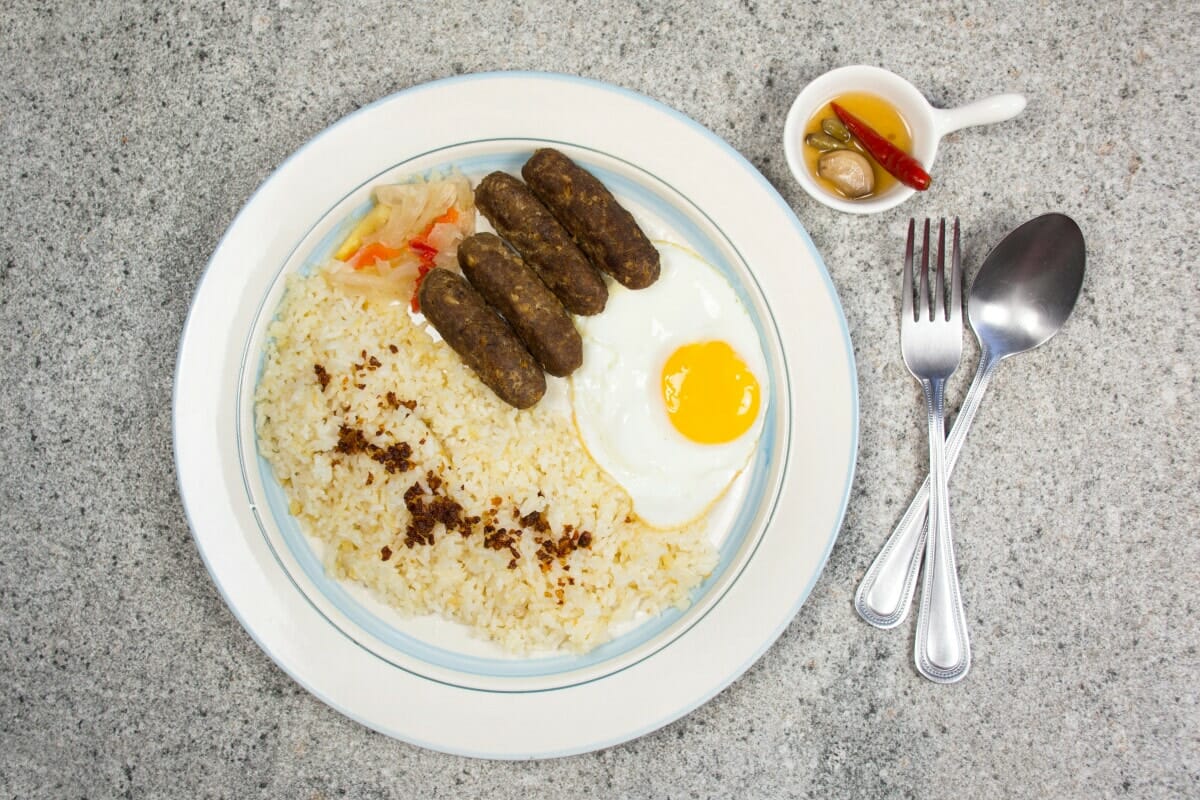
We can think of silog as a collective term used to describe a group of traditional Filipino breakfast meals that typically contain cured meats, fried egg and garlic-fried rice. Silog is an abbreviation of “si” as in sinangag, also known as garlic fried rice, and “log” from itlog the Filipino term for egg.
A popular silog combination is called tocilog, which uses tocino, a thick, sweetened bacon. Tapsilog is another variation of silog that uses tapa, a cured meat. The Filipino sweet and savory sausage known as longganisa is another prominent example.
And then we have slightly easier to prepare silogs with spam, fried milkfish belly, beefsteak, corned beef, hotdog, and chorizo. Combine these cured meats with fried garlic-rice, egg, with a side of achara (pickled papaya), and fresh sliced tomatoes and cucumbers or spiced vinegar. Appearing on menus everywhere from fast-food chains and street food stalls to hotels, silog is a flavor-packed filling Filipino breakfast dish that sets the day up to be a success.
Palabok

Palabok is usually served at fiestas and on special occasions. There are two versions of these bright orange rice noodle dish. One is pancit malabon, which uses palabok noodles, a thicker rice noodle with the sauce already mixed in. The other is pancit palabok, which uses a thinner rice noodle called bihon, and is served with the sauce as a topping. Both noodle recipes are drenched in water before being boiled.
The savory orange shrimp sauce is made with ground pork (or offal), garlic, onion, fish sauce, cornstarch (as a thickener), annatto powder (also known as “astuete”, the ingredient that gives the dish its iconic orange glow), and shrimp bouillon cubes (that create the base of the sauce).
Topped with sliced eggs, fried garlic, green onions, shrimps, and pork cracklings for an incredible crunchy texture. Some chefs use calamansi to give the palabok a slight tang and to alter the flavor profile of the dish.
Arroz Caldo
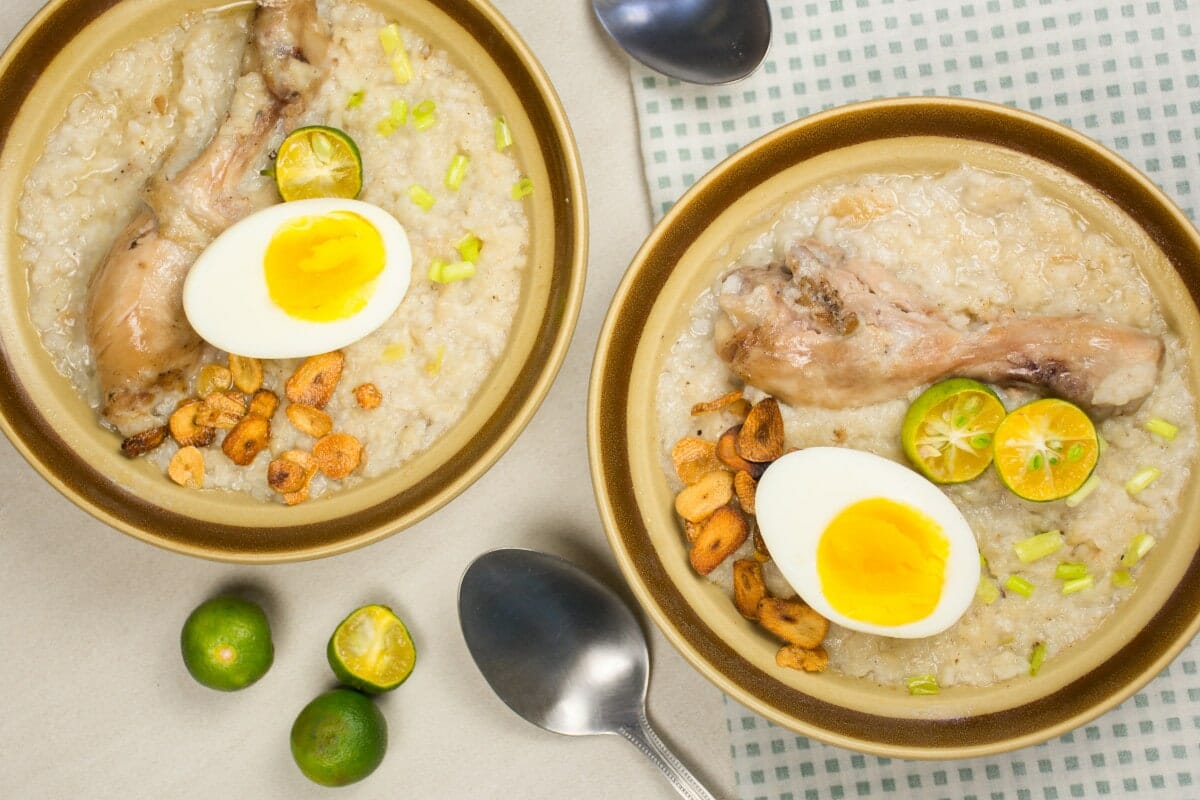
Arroz caldo is a filling chicken rice porridge similar to Chinese rice congee. This Spanish-Chinese influenced dish is enjoyed as any meal of the day: breakfast, ‘merienda’ or snack time, lunch or dinner. An easy-to-prepare one-pot recipe, arroz caldo is a classic Filipino comfort food best reserved for rainy and cold weather (yes, it does happen).
Arroz and caldo are Spanish words for rice and broth, respectively. And it’s the Spanish influence that inspired the adding of ingredients like chicken broth and astuete or saffron, used to lightly color the rice porridge. Chinese immigrants added rice and ginger to the mix. The Chinese also taught the method of making rice porridge.
Long grain rice or glutinous rice is boiled and infused with ginger, fish sauce, garlic, onions, and chicken broth. The dish is filled with whole or shredded chicken, garnished with a halved hard-boiled egg, calamansi, fish sauce, green onions and fried garlic to finish it. While eating chicken and porridge might sound strange, it’s definitely worth a try. It will surprise you how tasty it can be.
Cassava Cake
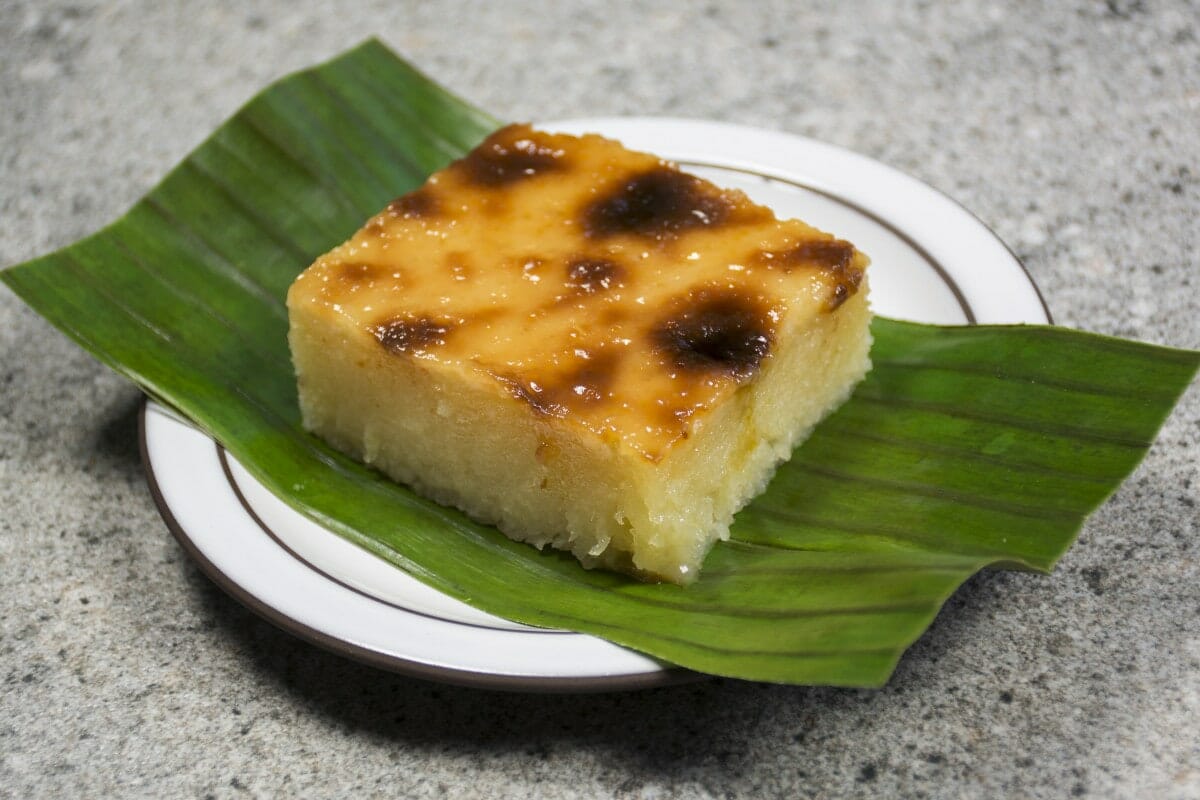
Kamoteng kahoy (cassava cake) is a sweet, chewy treat that you will almost always find in Filipino dessert buffet tables or at parties and special occasions.
Cassava, a root vegetable similar to a yam, was introduced and imported from Latin America to the Philippines in the 16th century and is the prime ingredient in this dessert which also includes eggs, flour, sugar, condensed milk and coconut milk. The cake is baked in pans lined with banana leaves or steamed to an almost translucent cream color. Then it’s cooled and doused with a sweet custard topping made of condensed milk mixed with coconut cream. But that’s not all. It’s then baked once more to solidify and create a golden brown top layer.
Halo-Halo
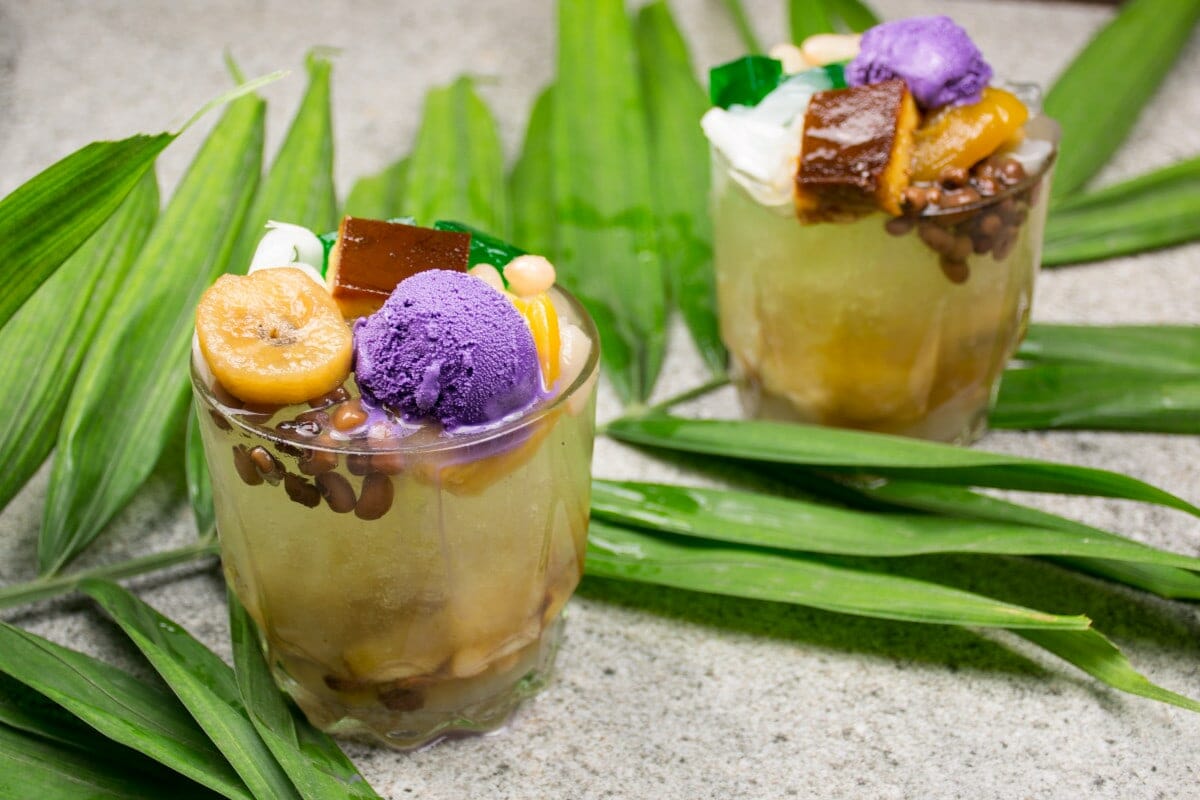
This cool-sounding dessert is a favorite in the hot summer months of March to June. Halo-halo is a simple shaved ice dessert that you can find for sale in Filipino street food stalls and small stores, as well as established restaurants and fast food chains.
Halo-halo’s origins can be traced back to the 1940s, where the inspiration came from kakigori, a Japanese shaved ice dessert decorated with flavored syrup, mochi, and red beans. Now reinvented and embraced by Filipinos with a unique take that uses a mixture of colorful toppings reminiscent of fiestas or parties. Toppings include preserved sweet fruits like saba bananas, macapuno or sweetened coconut meat, jackfruit, red beans, sago, garbanzos, sweet potato, nata de coco, an agar-agar like textured coconut gel, ube (purple yam) or sweet violet jam, and even leche flan, a Spanish crème caramel flan.
It’s all finished off with a big scoop of delicious ube ice cream. The ingredients top a mountain of crushed ice in a short, wide bowl or tall glass with fresh milk or evaporated milk.
Versions of Halo-Halo also include corn, corn flakes, vibrant colored gelatin, Rice Krispies. Some people use fresh fruits like mangoes, kiwis or oranges to create new and interesting variations.

Filipinos are naturally fun-loving, happy and welcoming people. Their bright smiles and spirit helped them take advantage of the different cultures and elements of the past by fusing Filipinos flavors and cooking techniques to create what we now discern as “Filipino cuisine”. If you get a chance to make a trip to the Philippines (the world's most underrated food destination), be sure to set aside time for trying each of these delicious foods.
If you're looking for more examples of popular Filipino foods, try Pork Sisig (sizzling minced pork belly), Buko Pie (delicious dessert), Kare Kare (beef in peanut sauce or peanut butter), Sweet & Sour Tilapia fried fish dish, or Pancit Guisado. Lumpia Shanghai is another popular Filipino street food that you will love.

Enjoyed the article, can the recipes be shared too?
Glad you liked the recipes, Helen. Where did you want to share them?